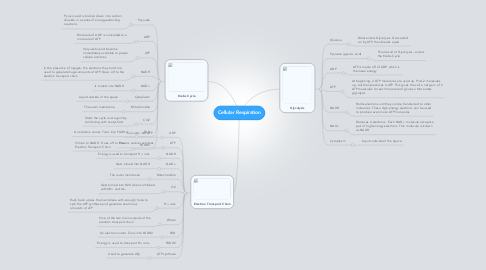
1. Krebs Cycle
1.1. Pyruvate
1.1.1. Pyruvic acid is broken down into carbon dioxide in a series of energy-extracting reactions
1.2. ADP
1.2.1. Molecule of ADP is converted to a molecule of ATP
1.3. ATP
1.3.1. Very useful and become immediately available to power cellular activities
1.4. NADH
1.4.1. In the presence of oxygen, the electrons they hold are used to generate huge amounts of ATP. Goes off to the electron transport chain
1.5. NAD+
1.5.1. Is turned into NADH
1.6. Cytoplasm
1.6.1. Liquid outside of the space
1.7. Mitochondria
1.7.1. The outer membrane
1.8. CO2
1.8.1. Starts the cycle over again by combining with acetyl-CoA
1.9. FAD
1.9.1. An electron carrier. Turns into FADH2
1.10. FADH2
1.10.1. Similar to NADH. Goes off to the Electron Transport Chain.
2. Electron Transport Chain
2.1. ADP
2.1.1. Converts into ATP
2.2. ATP
2.2.1. Powers cellular activities
2.3. NADH
2.3.1. Energy is used to transport H+ ions
2.4. NAD+
2.4.1. Gets turned into NADH
2.5. Mitochondira
2.5.1. The outer membrane
2.6. O2
2.6.1. Gets turned into H20 when combined with 4H+ and 4e-
2.7. H+ ions
2.7.1. Rush back across the membrane with enough force to spin the ATP synthase and generate enormous amounts of aTP
2.8. Water
2.8.1. One of the two main outputs of the electron transport chain
2.9. FAD
2.9.1. An electron carrier. Turns into FADH2
2.10. FADH2
2.10.1. Energy is used to transport H+ ions
2.11. ATP synthase
2.11.1. Used to generate ATp
3. Glycolysis
3.1. Glucose
3.1.1. What enters Glycolysis. Gets acted on by ATP, then breaks apart
3.2. Pyruvate (pyruvic acid)
3.2.1. Final result of Glycolysis - enters the Krebs Cycle
3.3. ADP
3.3.1. ATP is made off of ADP, which is the lower energy
3.4. ATP
3.4.1. At beginning, 2 ATP molecules are used up. Puts 2 molecules up, but then produces 4 ATP. This gives the cell a net gain of 2 ATP molecules for each molecule of glucose that enters glycolysis
3.5. NADH
3.5.1. Holds electrons untl they can be transferred to other molecules. These high-energy electrons can be used to produce even more ATP molecules
3.6. NAD+
3.6.1. Removes 4 electrons. Each NAD+ molecule accepts a pair of high-energy electrons. This molecule is known as NADH
3.7. Cytoplasm
3.7.1. Liquid outside of the space
